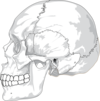
A question frequently asked by our patients, the answer is both childishly simple and really complex. It is simple because one could clearly answer "There is no such thing as cranial osteopathy" without being wrong. And it is complex because many of us have already heard of osteopaths using mostly (or even exclusively) cranial techniques. This deserves an attempt at clarification...
A good osteopath masters a set of techniques
An osteopath, if he has followed a complete and solid training, knows how to practice on the head of his patients when he judges that it is necessary for an efficient treatment, in the same way that he is able to manipulate a vertebral joint or to have a mechanical action on a visceral organ. It is in this sense that cranial osteopathy as such does not exist. It would be more accurate and coherent to speak of cranial techniques, just as there are articular, myotensive (muscular), visceral and many other techniques in osteopathy. We can also speak of cranial, articular, myotensive or visceral approaches. This is the denomination used by many osteopathic training establishments for whom this "division" of osteopathy is necessary for pedagogical and learning reasons. This is probably where the confusion comes from, the schools do not train "cranial osteopaths" nor "visceral osteopaths", but competent osteopaths, mastering all the tools that will allow them to take the best care of their patients, even if this diverse knowledge has been acquired from different teachers and speakers.
During his career, each osteo follows his own path, according to what he continues to learn (via continuing education) but also to the experience accumulated over the years of practice. Thus, each osteopath can develop a particular sensitivity for certain techniques because they are more efficient according to him, because they make more sense in what he understands about his patients or because he has acquired a greater mastery of certain osteopathic approaches through the repetition of gestures. All osteopaths experience this during their career and no one will tell you without lying that he is exactly the same osteopath today as he was 10 years ago, nor that he is sure to work exactly the same way in 10 years. This is why some practice with an approach more centered on the cranium, while others use these techniques much less in favor of other better known or mastered approaches. At the beginning, everyone has the same tools, but not everyone will use them in the same way and will therefore not have the same mastery after a few years of practice.
Science and cranial osteopathy

One could also answer that anyway the bones of the skull do not move, since except for the jaw, there is no other articulation of the head allowing a real mobility, whereas the whole cephalic skeleton includes about twenty distinct bones. This is true once the skull is completely ossified, in late adolescence. Yet when working on a patient's head, many practitioners are effective and many patients have experienced this. At the present time, the tools available to science unfortunately do not allow us to understand what the movements perceived by the osteopath correspond to, nor to explain their effectiveness. Some people consider that it is a placebo effect, it is possible and even probable in part, but there again it is impossible to affirm with certainty today. It is also quite probable that the mechanical action of the practitioner's pressure provokes a response from the body, notably through what is called connective tissue, and that it is this reaction from the body that leads to an improvement in the painful symptoms through complex but very real physiological processes. This is a fascinating and vertiginous subject, but it probably deserves another article...
Damien Fabre
Osteopath in Versailles
78 - Yvelines
